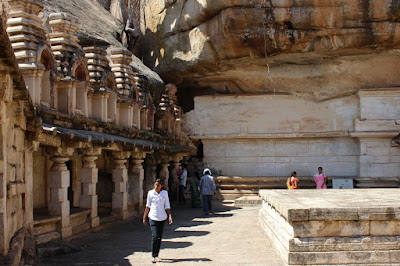ಶ್ರೀ ಜಗಜ್ಯೋತಿ ಬಸವೇಶ್ವರ ಎಂದೊಡನೆ, ಹಿಂದೂ ಧರ್ಮದಲ್ಲಿ ನಡೆದ ಕ್ರಾಂತಿಯ ಇನ್ನೊಂದು ಹೆಸರು ಎಂದೆನಿಸುತ್ತದೆ. 12ನೇ ಶತಮಾನದಲ್ಲಿಯೇ ಜಾತಿ-ಸಮಾಜದ ಕುರಿತು ಉನ್ನತ ವಿಚಾರ ಧಾರೆಗಳನ್ನು ಮಂಡಿಸಿದ ಮಹಾನುಭಾವ ಈ ಬಸವ. ಕೀಳು ಜಾತಿಯ ಜನರಿಗೆ ದೇವಸ್ಥಾನದಲ್ಲಿ ಪ್ರವೇಶವಿಲ್ಲ ಎಂದಿದ್ದಕ್ಕೆ, ತಮ್ಮ ದೇಹವನ್ನೇ ದೇಗುಲ ಮಾಡಿ ಸಣ್ಣ ಲಿಂಗವನ್ನು ಕೊರಳಲ್ಲಿ ಕಟ್ಟಿಕೊಂಡು ಪೂಜಿಸಲು ಹೇಳಿಕೊಟ್ಟು, ಅವರಿಗೆ ಜಂಗಮರೆಂದು ಕರೆದು ವೀರಶೈವ ಅಥವಾ ಲಿಂಗಾಯತ ಎಂಬ ಹೊಸ ಪದ್ಧತಿಗೆ ನಾಂದಿ ಹಾಡಿದ ಚೈತನ್ಯ ವ್ಯಕ್ತಿ!
ಬಸವೇಶ್ವರರು 12 ನೇ ಶತಮಾನದಲ್ಲಿ, ಬಿಜಾಪುರ ಜಿಲ್ಲೆಯ, ಹುನಗುಂದ ತಾಲೂಕಿನ ಬಾಗೇವಾಡಿ ಎಂಬಲ್ಲಿ ಜನಿಸಿದರು. ಇವರ ತಂದೆ ಮಾದರಸ (ಮಾದರಾಜ) ಆ ಊರಿನ ಮುಖ್ಯಸ್ಥರಾಗಿದ್ದರು. ತಾಯಿ ಮಾದಲಾಂಬಿಕೆ. ಶೈವ ಬ್ರಾಹ್ಮಿನರಾದ ಇವರು ಶಿವನನ್ನು ಪೂಜಿಸುತ್ತಿದ್ದರು.ಆದ್ದರಿಂದ ಶಿವನ ವಾಹನವಾದ ಬಸವಣ್ಣನ ಹೆಸರನ್ನೇ ಮಗನಿಗೆ ಇಟ್ಟರು.
ಬಸವ ಕೃಷ್ಣ ಹಾಗೂ ಮಲಪ್ರಭಾ ನದಿಯ ದಡದಲ್ಲಿರುವ ಕೂಡಲಸಂಗಮದಲ್ಲೇ ಬೆಳೆದರು. ತಮ್ಮ ಬಾಲ್ಯದ 12 ವರ್ಷಗಳನ್ನು ಕೂಡಲಸಂಗಮದ ಹಿಂದೂ ದೇವಾಲಯವಾದ ಸಂಗಮೇಶ್ವರ ದೇವಾಲಯದಲ್ಲಿ ವಿದ್ಯಾಭ್ಯಾಸ ಮಾಡುತ್ತ ಕಳೆದರು. ಜಾತವೇದ ಮುನಿ (ಈಶಾನ್ಯ ಗುರು) ಬಸವೇಶ್ವರರ ಗುರುಗಳಾಗಿದ್ದರು.
ಬಸವೇಶ್ವರರು ತಮ್ಮ ತಾಯಿಯ ಸಂಬಂಧಿಯಾದ ಗಂಗಾಂಬಿಕೆ ಮತ್ತು ಅವಳ ಸಖಿ ನೀಲಾಂಬಿಕೆಯನ್ನು ಮದುವೆಯಾದರು. ನಂತರ ಕಲ್ಯಾಣದಿಂದ ಆಳುತ್ತಿದ್ದ ಕಲಚೂರಿ ರಾಜನಾದ ಬಿಜ್ಜಳನ ಆಸ್ಥಾನದಲ್ಲೇ ಲೆಕ್ಖಲಿಗನಾಗಿ ಸೇರಿಕೊಂಡರು. ರಾಜನ ಮಂತ್ರಿ ತೀರಿಕೊಂಡ ನಂತರ ರಾಜ ಆ ಸ್ಥಾನವನ್ನು ಬಸವೇಶ್ವರರು ಅಲಂಕರಿಸುವಂತೆ ಹೇಳಿ ಕಳುಹಿಸಿದ. ಅಲ್ಲದೆ ರಾಜ ಬಸವೇಶ್ವರರ ಸೋದರಿ ಪದ್ಮಾವತಿಯನ್ನು ಮದುವೆಯಾದ.
 |
| 116 feet tall Basaveshwara at Gadag |
ಮಂತ್ರಿಯಾದ ನಂತರ ಬಸವೇಶ್ವರರು ರಾಜ್ಯದ ಖಜಾನೆಯನ್ನು ಅನೇಕ ಒಳ್ಳೆಯ ಕಾರ್ಯಗಳಿಗೆ ಉಪಯೋಗಿಸತೊಡಗಿದರು. ಸಮಾಜದ ಪುನರ್ ರಚನೆ, ಶೈವ ಧರ್ಮಕ್ಕೆ ಸಂಬಂಧಿಸಿದಂತೆ ಧಾರ್ಮಿಕ ಚಳುವಳಿಗಳು, ಈ ಕಾರ್ಯಗಳಲ್ಲಿ ತೊಡಗಿರುವ ಜಂಗಮರ ಉದ್ಧಾರ ಮುಂತಾದ ಕಾರ್ಯಗಳು ಅದೇ ಸಮಯದಲ್ಲಿ ನಡೆದವು. ಅಲ್ಲದೆ ಪ್ರಸಿದ್ಧವಾದ, ನೂತನ ವಿಚಾರಧಾರೆಗಳನ್ನೊಳಗೊಂಡ ಅನುಭವ ಮಂಟಪ ಎಂಬ ಸಂಘವು ಆಗಲೇ ರಚನೆಯಾಯಿತು. ಇದು ದೂರ-ದೂರ ದೇಶದ, ರಾಜ್ಯದ ಬೇರೆ ಬೇರೆ ಜಾತಿಯ, ಹೆಣ್ಣು ಗಂಡು ಎಂಬ ಭೇದವಿಲ್ಲದೆ ಎಲ್ಲ ತರಹದ ಜನಗಳಿಗೆ ಒಂದು ಸಾರ್ವಜನಿಕ ವೇದಿಕೆಯಾಗಿತ್ತು. ಇಲ್ಲಿ ಎಲ್ಲ ತರಹದ ಜನರು ಬಂದು, ಆಧ್ಯಾತ್ಮಿಕ, ಆರ್ಥಿಕತೆ ಹಾಗೂ ಸಾಮಾಜಿಕ ಸಮಸ್ಯೆಗಳ ಕುರಿತು ತಮ್ಮ ವಿಚಾರಗಳನ್ನು ವ್ಯಕ್ತಪಡಿಸುತ್ತಿದ್ದರು. ಹಾಗೂ ಸಮಾಜದ ಏಳಿಗೆಯ ಕುರಿತು ವಿಚಾರ ಮಂಡನೆ ಮಾಡಿ, ಆಚರಣೆಗೆ ತರುವ ಕುರಿತು ಯೋಚಿಸುತ್ತಿದ್ದರು. ಅದಕ್ಕೆಂದೇ ಬಸವೇಶ್ವರರು ಹಾಗೂ ಅನುಭವ ಮಂಟಪದಲ್ಲಿ ಪಾಲ್ಗೊಂಡ ಎಷ್ಟೋ ಜಂಗಮರು ಅಲ್ಲಿಯ ಸ್ಥಳೀಯ ಭಾಷೆಯಲ್ಲೇ ಸಾಮಾನ್ಯ ಜನರಿಗೆ ಅರ್ಥವಾಗುವಂತೆ ವಚನಗಳ ರಚನೆ ಮಾಡಿ ಅವುಗಳನ್ನು ಜನರಿಗೆ ತಲುಪುವಂತೆ ಮಾಡಿದರು. ಆಗಿನ ಕಾಲದಲ್ಲಿ ಜಾತಿವಾದ ಪದ್ಧತಿಯನ್ನು ಖಂಡಿಸಲೆಂದೇ ಬಸವೇಶ್ವರರು ಲಿಂಗಾಯತ ಎನ್ನುವ ಮತ ಮಾಡಿ ಅದರಲ್ಲಿ ಲಿಂಗ ಪೂಜೆ ಮಾಡುವ ಯಾವುದೇ ವ್ಯಕ್ತಿ ಇರಬಹುದು ಅವನು ಶಿವನ ಕೃಪೆಗೆ ಪಾತ್ರನಾಗುತ್ತಾನೆ ಎಂದು ಎಲ್ಲ ಜಾತಿಯ ಜನರಿಗೂ ವ್ಯಕ್ತಿತ್ವ ರೂಪಿಸಿಕೊಳ್ಳಲು ಅವಕಾಶ ನೀಡಿದರು. ಜಾತಿವಾದವನ್ನು ಖಂಡಿಸಿ ಅಂತರ್ ಜಾತಿ ವಿವಾಹವನ್ನೂ ಕೂಡ ಮಾಡಿಸಿದರು. ಈ ಎಲ್ಲ ಕಾರಣಗಳಿಂದ ಸಮಾಜದಲ್ಲಿರುವ ಅಂಬಿಗ, ಕಮ್ಮಾರ, ಕುಂಬಾರ, ಚಮ್ಮಾರ ಮುಂತಾದ ಎಲ್ಲ ಜಾತಿಯ ಜನರಲ್ಲೂ ಬಸವೇಶ್ವರರಲ್ಲಿ ಪ್ರೀತಿ ಗೌರವ ಮೂಡಿತು. ಚಮ್ಮಾರ ಹರಳಯ್ಯನೆಂಬ ಶರಣ ಮತ್ತು ಅವನ ಹೆಂಡತಿ ಕಮಲಮ್ಮ ತಮ್ಮ ತೊಡೆಯ ಚರ್ಮದಿಂದ ಬಸವೇಶ್ವರರಿಗೆ ಪಾದರಕ್ಷಗಳನ್ನು ಮಾಡಿ ಅರ್ಪಿಸಲು ಹೋದದ್ದು, ಅವರು ಪಾದುಕೆಗಳನ್ನು ತಲೆಯಮೇಲಿಟ್ಟು ಶಿವಾರ್ಪಣೆ, ಇವುಗಳನ್ನು ನಾನು ಕಾಲಲ್ಲಿ ಮೆಟ್ಟಲಾರೆ ಎಂದು ಹೇಳಿ ಮರಳಿ ಕಳಿಸಿದ್ದು ನಾವು ಓದಿದ್ದೀವಿ. ಈ ರೀತಿ ಸಾಮಾಜಿಕ ಶಿಕ್ಷಣ ಹಾಗೂ ವಚನಗಳ ಮೂಲಕ ಆಗಿನ ಕಾಲದಲ್ಲೇ ಕ್ರಾಂತಿ ಎಬ್ಬಿಸಿದ ಬಸವೇಶ್ವರರು ಎಲ್ಲ ಉಚ್ಚ ಜಾತಿಯ ಜನರ ಕಣ್ನುಕೆಸರಾದರು. ಈ ಜನಗಳು ಬಸವೇಶ್ವರರ ವಿರುದ್ಧ ರಾಜನ ಕಿವಿ ತುಂಬಿದ ಮೇಲೆ,ಇದನ್ನು ತಿಳಿದ ಬಸವ ಮಂತ್ರಿ ಪಧವಿಗೆ ರಾಜೀನಾಮೆ ಕೊಟ್ಟು, ಕೂದಲ ಸಂಗಮಕ್ಕೆ ಸಾಗಿ ಅಲ್ಲೇ ಲಿಂಗೈಕ್ಕ್ಯರಾದರು.
 |
| 108 feet tall Basava at Basava Kalyana |
ಹಾಲತೊರೆಗೆ ಬೆಲ್ಲದ ಕೆಸರು, ಸಕ್ಕರೆಯ ಮೊಳಲು
ತವರಾಜದ ನೊರೆ ತೆರೆಯಂತೆ ಆದ್ಯರ ವಚನವಿರಲು
ಬೇರೆ ಬಾವಿ ತೋಡಿ ಉಪ್ಪ್ ನೀರ ನುಂಬುವನಿಧಿಯಂತೆ
ಆಯಿತೆನ್ನಮತಿ ಕೂಡಲಸಂಗಮದೇವ |
ಸುಪ್ರಭಾತ ಸಮಯದಲ್ಲಿ ಅರ್ಥಿಯಲ್ಲಿ ಲಿಂಗವ ನೆನೆದೊಡೆ
ತಪ್ಪುವವು ಅಪಮೃತ್ಯು ಕಾಲ ಕರ್ಮಂಗಳಯ್ಯ
ದೇವ ಪೂಜೆಯ ಮಾಟದುರಿತ ಬಂಧನದೂಟ
ಶಂಭು ನಮ್ಮಯ ನೋಟ ಹಿಂಗದ ಕಣ್ಬೀಟ
ಸದಾ ಸನ್ನಿಹಿತನಾಗಿ ಶರಣೆಂಬುದು ನಂಬುದು
ಜಂಗಮಾರ್ಚನೆಯ ಮಾಟ ಕೂಡಲಸಂಗನ ಕೂಟ |
ಉಳ್ಳವರು ಶಿವಾಲಯ ಮಾಡುವರಯ್ಯ
ನಾನೇನು ಮಾಡಲಿ ಬಡವನಯ್ಯ
ಎನ್ನ ಕಾಲೇ ಕಂಬ, ದೇಹವೇ ದೇಗುಲ
ಶಿರವೇ ಹೊನ್ನ ಕಳಶವಯ್ಯ,
ಕೂಡಲಸಂಗಮದೇವ ಸ್ಥಾವರಕ್ಕಳಿವುಂಟು ಜಂಗಮಕ್ಕಳಿವಿಲ್ಲ |
ಜಗವ ಸುತ್ತಿರುವದು ನಿನ್ನಯ ಮಾಯೆ
ನಿನ್ನ ಸುತ್ತಿರುವದು ಎನ್ನ ಮನ ನೋಡ
ಕರಿಯೂ ಕನ್ನಡಿಯೊಳ್ ಅಡಗಿದಂತಯ್ಯಾ
ನೀ ಎನ್ನೋಳಡಗಿದೆ ಕೂಡಲಸಂಗಮದೇವ |
ಹಂದಿಯೂ ಮದಕರಿಯು ಒಂದೇ ದಾರಿಯಲ್ಲಿ ಸಂಧಿಸಿದೆಡೆ
ಹಂದಿಗಂಜಿ ಮದಕರಿ ಕೆಲಕ್ಕೆ ಸಾರಿದೆಡೆ
ಹಂದಿಗೆ ಕೇಸರಿಯಪ್ಪುದೆ ಕೂಡಲಸಂಗಮದೇವ |
.........



































